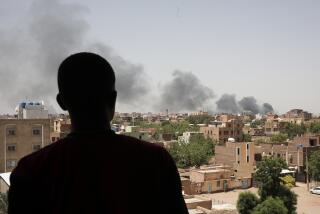U.S. Won’t Rule Out Troop Use to Defend Kurds
- Share via
WASHINGTON — Kurdish refugees fleeing Iraq are dying at a rate of up to 1,000 a day, the State Department said Monday, and the White House for the first time publicly acknowledged the possibility that U.S. troops may have to enter northern Iraq to defend refugees from Saddam Hussein’s attacks.
“Supplies and medical assistance are being moved in as fast as is humanly possible,” State Department spokesman Margaret Tutwiler said. Still, she added, relief groups on the Iraqi-Turkish border “estimate that between 400 and 1,000 people there are dying every day, mostly from preventable diseases.” No estimate exists of deaths among refugees in the Iraq-Iran border region.
Moreover, Tutwiler said, the toll is expected to mount with about 1 million refugees having fled from Iraq into Iran and nearly 400,000 into Turkey and a similar number still camped on the Iraqi side of the border.
(Some sources in the region have reported that as many as 500,000 Kurds have fled Iraq for Turkey, while there are 1 million more Kurds waiting to cross the frontier with Iran.)
As fears continued of Iraqi attacks against the fleeing Kurds, White House spokesman Marlin Fitzwater pointedly declined to rule out the use of U.S. troops to protect refugee areas or to help with refugee aid within Iraqi territory.
“I couldn’t be that categorical,” Fitzwater said when asked if he could rule out deployment of U.S. forces in northern Iraq. “You can’t say there won’t be some moving in and out.”
In the past, Administration officials privately have conceded that the U.S. hope of staying solely on the Turkish side of the border may be impossible, but Fitzwater’s remarks were the first public admission. The United States now has about 8,000 military personnel in Turkey working on the refugee effort.
Fitzwater also conceded that the Administration has given up the goal, announced only last week, of turning the refugee effort over to international groups within a month. “We hope that they’ll be able to do the job themselves as fast as possible,” he said. “The end of the month part, I don’t know about that.”
Refugee deaths are likely to mount in coming days, Tutwiler said. “As each day goes by, these people become weaker,” she said. Besides disease, she noted, refugees may face man-made dangers.
“There have been some reports that we saw this morning of shootings (of refugees) by Turkish military,” she said. “We can neither confirm nor deny the reports of alleged shooting of refugees or looting of relief supplies. We are checking on these reports and we obviously certainly hope that they are not correct.”
British Prime Minister John Major on Friday said that Western countries may need to consider using force to protect the Kurds from the Iraqi army. At the White House, spokesman Fitzwater was less direct but said the Bush Administration generally agrees.
“Whether or not you should have forces actually in the camps, and how many, what they should do, that sort of thing” is still under discussion, Fitzwater said. But, he added, “the overall objective of ensuring the safety of the camps and having a military backup of some kind is agreed upon by all parties. I think we’re together on that.”
While those discussions continue, Administration officials conceded that the early days of the relief effort have been difficult. “The problem you have,” Fitzwater said, “is you have people just sitting there on the side of a mountain. There are no roads in, there’s no railways, there’s no airstrips. It’s very difficult geographically to organize the distribution.”
Because of that, “we’re dropping supplies there as fast as we can all over, but geographically you’re still pretty much limited to kind of a helter-skelter distribution system on the ground where people pick up supplies basically wherever they can get it.”
As of Monday, U.S., British and French air forces had flown 152 air-drop missions to the northern border area, delivering more than 1,029 tons of supplies, Fitzwater said. At the same time, about 30,000 refugees are now crowded into camps in that part of southern Iraq originally occupied by the U.S.-led coalition.
Administration officials have said that after U.S. troops have finished pulling out, refugees will be protected by a United Nations observer force that will move into a nine-mile-wide buffer zone straddling the Iraq-Kuwait border.
Tutwiler, however, conceded that she did not know if U.N. observers would be trained or equipped to fight, if necessary to protect refugees in the area under their control. The United States plans to contribute about 20 people to the 1,440-member U.N. force.
More to Read
Sign up for Essential California
The most important California stories and recommendations in your inbox every morning.
You may occasionally receive promotional content from the Los Angeles Times.













